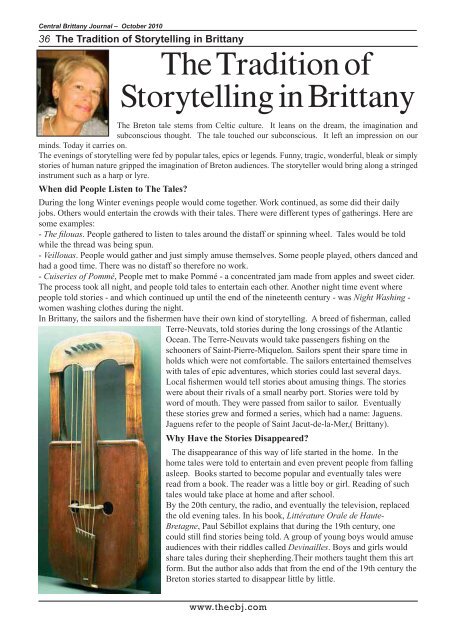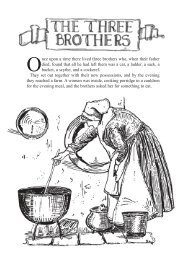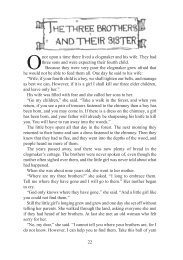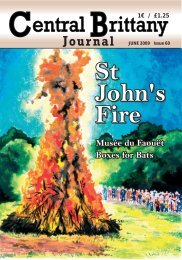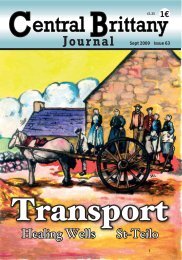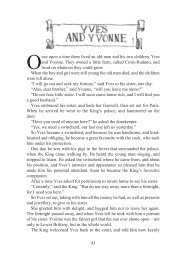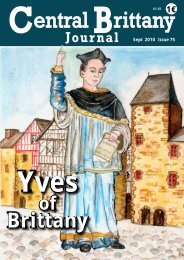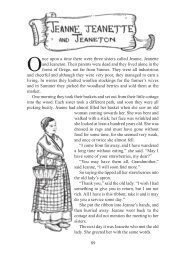Central Brittany Journal – October 201036 The Tradition of Storytelling in BrittanyThe Tradition ofStorytelling in BrittanyThe <strong>Breton</strong> tale stems from Celtic culture. It leans on the dream, the imagination andsubconscious thought. The tale touched our subconscious. It left an impression on ourminds. Today it carries on.The evenings of storytelling were fed by popular tales, epics or legends. Funny, tragic, wonderful, bleak or simplystories of human nature gripped the imagination of <strong>Breton</strong> audiences. The storyteller would bring along a stringedinstrument such as a harp or lyre.When did People Listen to The Tales?During the long Winter evenings people would <strong>com</strong>e together. Work continued, as some did their dailyjobs. Others would entertain the crowds with their tales. There were different types of gatherings. Here aresome examples:- The filouas. People gathered to listen to tales around the distaff or spinning wheel. Tales would be toldwhile the thread was being spun.- Veillouas. People would gather and just simply amuse themselves. Some people played, others danced andhad a good time. There was no distaff so therefore no work.- Cuiseries of Pommé, People met to make Pommé - a concentrated jam made from apples and sweet cider.The process took all night, and people told tales to entertain each other. Another night time event wherepeople told stories - and which continued up until the end of the nineteenth century - was Night Washing -women washing clothes during the night.In Brittany, the sailors and the fishermen have their own kind of storytelling. A breed of fisherman, calledTerre-Neuvats, told stories during the long crossings of the AtlanticOcean. The Terre-Neuvats would take passengers fishing on theschooners of Saint-Pierre-Miquelon. Sailors spent their spare time inholds which were not <strong>com</strong>fortable. The sailors entertained themselveswith tales of epic adventures, which stories could last several days.Local fishermen would tell stories about amusing things. The storieswere about their rivals of a small nearby port. Stories were told byword of mouth. They were passed from sailor to sailor. Eventuallythese stories grew and formed a series, which had a name: Jaguens.Jaguens refer to the people of Saint Jacut-de-la-Mer,( Brittany).Why Have the Stories Disappeared?The disappearance of this way of life started in the home. In thehome tales were told to entertain and even prevent people from fallingasleep. Books started to be<strong>com</strong>e popular and eventually tales wereread from a book. The reader was a little boy or girl. Reading of suchtales would take place at home and after school.By the 20th century, the radio, and eventually the television, replacedthe old evening tales. In his book, Littérature Orale de Haute-Bretagne, Paul Sébillot explains that during the 19th century, onecould still find stories being told. A group of young boys would amuseaudiences with their riddles called Devinailles. Boys and girls wouldshare tales during their shepherding.Their mothers taught them this artform. But the author also adds that from the end of the 19th century the<strong>Breton</strong> stories started to disappear little by little.www.<strong>thecbj</strong>.<strong>com</strong>
www.<strong>thecbj</strong>.<strong>com</strong>Central Brittany Journal – October 2010The Tradition of Storytelling in Brittany 37The <strong>Breton</strong> Story today:At present stories are making a successful <strong>com</strong>eback in Brittany, as in all of France. Theintroduction of these tales through the school system helps keep these old tales alive today. Old stories andmodern tales are told by storytellers in matinees or evening shows.Have a good time with “The Visit of Autumn and “Les Contes de Cathie”AutumnOne morning, the little man entered into my garden. He greeted me with a bright, interested stare, that wasnot, however, the least impertinant. He was brightly dressed in all the colours of the Autumn leaves - gold,brown, green, red, and orange.From the Woodland Haberdashery, he had chosen buttons made of acorns and chestnuts; and for thread he hadchosen strands of dried tall grasses.And his big black hat? Where did that <strong>com</strong>e from? He had simply put on one of the heavy dark clouds, filledwith raindrops, drizzle and fog.The smoke from his pipe was the smoke of all of the fireplaces in our valley, pushing away cold and damp.Seeing him force his way into my garden didn't really surprise me because for a few days he had been sendingsigns of <strong>com</strong>ing. I could see the small caustic breaths of air, and the sunbeams tired by their long summerjourney stretch and lengthen from the horizon.Entering into my lounge, he was quite confused because of the water which dropped off his multicolouredrags. He left by the wide open bay exit through which the sun shone and very slowly crossed the garden.At night, I saw his bright colours disappear in the darkness, leaving only the track of the mist which started torise and envelop the houses.I was not worried. I knew that tomorrow he would be there in his early season clothes. Of course, in someweeks from now, his colours would have waned a little. But what did that matter! The little man had taken thetime to charm the eye of many romantic painters and melancholic dreamers. Those painters and dreamers whosee only the charm and beauty of autumn fruits and ripe olives, as full of scents and flavours, as the Autumn is ofcolours.Le bonhomme entra, un matin, dans mon jardin. Il me salua sans insolence, mais avec le regard ensoleillé etlumineux. Vêtu de haillons multicolores, il avait rassemblé tous les colors, les bruns, les verts et quelque rougeet orangé. Il avait vraiment revêtu une tenue des plus chamarrées.Au rayon, mercerie des bois et des forêts, il avait choisi des boutons parmi les glands et les châtaignes; etpour fil, de hautes herbes séchées.Et son grand chapeau noir? D’où le tenait-il? Il avait simplement coiffé les lourds nuages sombres chargés depluies, de bruines et de brouillards.Le fourneau de sa pipe fumait de toutes les vapeurs des cheminées de la vallée, tentant de repousser froidureet humidité.Je n’étais pas vraiment surprise de le voir ainsi pénétrer dans mon jardin, car depuis quelques jours, il avaitenvoyé des émissaires. Petits souffles de vent plus mordants, rayons de soleil plus fatigués par leur longuecourse de l’été, qui s’étiraient et s’allongeaient depuis l’horizon.En entrant dans mon salon, il fut tout confus de l’humidité qui dégoûtait de ses haillons. Il ressortit par labaie grande ouverte sur le soleil et traversa lentement, très lentement, le jardin.A la nuit venue, j’ai vu disparaître ses lumineuses couleurs dans l’obscurité, ne laissant que la trace de labrume qui se levait pour envelopper les demeures fumantes.Je n’étais pas inquiète. Je savais que demain, ilserait au rendez-vous dans ses atours de début de saison. Bien sûr dans quelques semaines, ses couleurs auraientquelque peu passé. Mais qu’importe ! Le bonhomme aurait pris le temps de charmer l’œil des peintres et desrêveurs mélancoliques qui ne voient en l’automne… que…. charme et beauté des fruits et des vies mûres, aussiriches d’expériences que l’automne l’est de couleurs !!!


